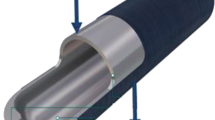Abstract
The Tiber reinforced composite material is widely used in the multi-industrial field because of their high specific modulus and specific strength. It has two main merits which are to cut down energy by reducing weight and to prevent explosive damage proceeding to the sudden bursting which is generated by the pressure leakage condition. Therefore, Pressure vessels using this composite material can be applied in the field such as defence industry and aerospace industry. In this paper, for nonlinear finite element analysis of E-glass/epoxy filament winding of composite vessel subjected to internal pressure, the standard interpretation model is developed by using the ANSYS with AutoLISP and ANSYS APDL languages, general commercial software, which is verified as useful characteristic of the solution. Among the modules of the system, both the process planning module for carrying out the process planning of filament wound composite pressure vessel and the autofrettage process module for obtaining higher residual stress will minimize trial and error and reduce the period for developing new products. The system can serve as a valuable system for experts and as a dependable training aid for beginners.
Similar content being viewed by others
References
Avitzur, B., 1983, Handbook of Metal Forming Processes, John Willey & Sons.
Cho Y. T., 2002, “Incremental Damage Mechanics of Particle or Short-Fiber Reinforced Composites Including Cracking Damage,”KSME International Journal, Vol. 16, No. 2, pp. 192–202.
Iliescu, C, 1990, Cold Pressing Technology,Elsevier, pp. 257–398.
Koh, S. K., 1993, “Residual Stress Analysis of an External Grooved Thick-Walled Pressure Vessel,”KSME International Journal, Vol. 7, No. 3, pp. 194–202.
Koh, S. K., 2000, “Elastic-Plastic Stress Analysis and Fatigue Lifetime Prediction of Cross- Bores in Autofrettage Pressure Vessels,”KSME International Journal, Vol. 14, No. 9, pp. 935–946.
Mi X., Yang, Y. and Liang, Y., 1993, “Experimental Study on Ironing of Stainless Steel and Optimization of Process Parameters,”Advanced Technology of Plasticity, Vol.3, pp. 1653–1656.
Oh, D. J., 2002, “Ductile Fracture Behavior of AS4P Under Mixed Mode (I/II) Loading,”KSME International Journal, Vol.16, No. 4, pp. 476–484.
Park, S. B., Kim, B. M. and Choi, J. C, 1999, “A CAD/CAM System for Deep Drawing Dies in a Simple-Action Press,”Journal of Materials Processing Technology, Vol. 87, No. 15, pp. 258–265.
Shimid. W. and Reissner, J.. 1982, “Critical Deformation in the Ironing of Deep-Draw Cups,”Int. J. of Mech., pp. 597–604.
Author information
Authors and Affiliations
Corresponding author
Rights and permissions
About this article
Cite this article
Park, JH., Kim, C. & Choi, JC. An integrated CAD/CAM system for CNG pressure vessel manufactured by deep drawing and ironing operation. KSME International Journal 18, 904–914 (2004). https://doi.org/10.1007/BF02990862
Received:
Revised:
Published:
Issue Date:
DOI: https://doi.org/10.1007/BF02990862




